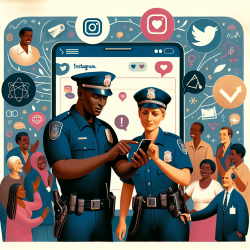Introduction
In today's digital age, social media platforms like Instagram have become crucial tools for organizations, including public police services, to communicate with the public. The research article "The visual politics of public police Instagram use in Canada" by Kevin Walby and Blair Wilkinson explores how police services in five Canadian cities utilize Instagram to manage their image and communicate with the community. This blog post aims to provide practitioners with insights from this research, encouraging them to reflect on their social media strategies and explore the implications of visual politics in their communications.
Understanding Visual Politics in Police Communications
The research highlights that police Instagram communications are heavily reliant on visual content, which plays a significant role in framing community and diversity. By employing discourse and semiotic analysis, the study examines how police use images to create positive affective relations with the community, often amplifying policing myths and enhancing police legitimacy.
For practitioners, understanding the power of visual politics is essential. Images on social media can blur the lines between authenticity and fantasy, creating a "fantastical authenticity" that can shape public perception. By strategically selecting images and narratives, police services can craft myths that reinforce organizationally acceptable stories, sometimes at the expense of silencing critical voices or omitting certain truths.
Key Takeaways for Practitioners
- Curate Authentic Narratives: Practitioners should strive to create authentic narratives that reflect the true diversity and community engagement efforts of their organizations. This involves being transparent about challenges and addressing criticisms openly.
- Balance Visual and Textual Content: While images are powerful, combining them with thoughtful textual content can provide a more comprehensive narrative. Practitioners should ensure that captions and narratives accompany images to convey the full story.
- Engage with Diverse Communities: Representation matters. Practitioners should ensure that their communications reflect the diversity of the communities they serve. This includes showcasing diverse voices and experiences within their organizations.
- Address Silences and Omissions: It's crucial to recognize and address any strategic silences or omissions in communications. Practitioners should be mindful of what is not depicted and strive to provide a balanced perspective.
Encouraging Further Research
The research by Walby and Wilkinson provides a foundation for understanding the visual politics of police Instagram use. However, there is still much to explore. Practitioners are encouraged to conduct further research into the impact of social media communications on public perception and community relations. This could involve examining the effectiveness of different strategies, analyzing audience engagement, and exploring the role of social media in shaping organizational culture.
Conclusion
As police services continue to navigate the digital landscape, understanding the visual politics of social media communications is crucial. By implementing the insights from this research, practitioners can enhance their skills and develop more effective communication strategies that resonate with their communities.
To read the original research paper, please follow this link: The visual politics of public police Instagram use in Canada.










